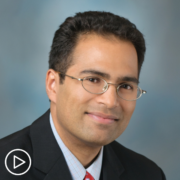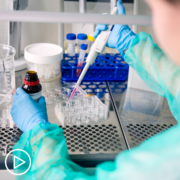Essential Thrombocythemia Watch & Wait | What Patients Should Know
Essential Thrombocythemia Watch & Wait | What Patients Should Know from Patient Empowerment Network on Vimeo.
What is watch and wait, and what does it mean for essential thrombocythemia (ET) patients? Dr. Naveen Pemmaraju defines this term, helps viewers to understand why it’s beneficial to wait before beginning treatment, and shares advice for managing the worry that can be associated with this time period.
Dr. Naveen Pemmaraju is Director of the Blastic Plasmacytoid Dendritic Cell Neoplasm (BPDCN) Program in the Department of Leukemia at The University of Texas MD Anderson Cancer Center. Learn more about Dr. Pemmaraju.
Related Programs:

|

|

Advances in Research | Emerging MPN Therapies on the Horizon |
Transcript:
Katherine Banwell:
Stephanie writes, “I have ET, and I’m not being treated. Do you have advice for the watch-and-wait period? I’m anxious about the disease changing and don’t know what I’m waiting for.” So, before you answer the question, Dr. Pemmaraju, would you define this term, watch and wait?
Dr. Pemmaraju:
I will. And to Stephanie and everyone out there, this is a great question. I will say half the folks I talk to actually call it watch and worry, okay. Some people call it watch and wait, and as Stephanie’s saying, some people call it watch and worry.
Yeah, the concept is threefold. One is that there are many cancers, many cancers, including blood cancers, that can be caught so early on that they don’t require treatment. A lot of patients with CLL, chronic lymphocytic leukemia, ET, as Stephanie mentioned, in the solid tumor. It’s very common to be diagnosed with a prostate cancer that’s low grade, early stage that can be observed. Number two is in ET, there is a science behind it.
What we found in our studies, and they can be updated over time and you’ll see those, the traditional is that if you’re below the age of 60 and/or you’ve had no blood clot, thrombotic event, that’s considered low risk. And the treatment can be observation, perhaps adding in a baby aspirin to prevent against blood clots if there’s no contraindication. Now what’s magic about that age 60, obviously as you know, it’s not magic. It’s more of a statistical, continuous variable algorithm that says around that time, the risk of blood clots goes up.
And so then you’d consider cytoreductive therapy at that point. Now there’s exceptions to that. Many of our young patients are on therapy, but there’s usually some reason for that. Some high-risk feature, wildly uncontrolled blood counts, for example, symptom burden, some other high-risk features. So, it’s a suggestion. It’s a guideline, not an absolute. And then the third part of it is, the what do you do in that time? And that’s the frustrating thing. And I think that’s what Stephanie’s getting to.
Again, that’s why I said the watch and worry versus watch and wait. Some of it is, how are you feeling outside of this? Some patients take it as a great news. Hey, you have this blood cancer, that’s not good news. But the good news is it’s probably not going to be active for a long time, we can, “just watch it.” But some people, as Stephanie is saying, take it the opposite way. What do you mean I got a blood cancer? I got something lurking in my body. You’re telling me it’s there, you know it’s there. And so what’s up with that? And the concept there is that some of these situations like low-risk ET, we found that if you treat too early, too aggressively, you can actually do harm.
So, that’s the key. These chemo drugs are not benign as you had me discuss earlier. They have toxicity, side effects, short-term, long-term. So, it’s a risk-benefit thing. If the risk far outweighs the benefit, as in the younger patient with no symptoms, no high-risk features, observation is okay. But at some point, when it turns, that’s the threshold.
So, really the key is, if we believe these are stem cell blood cancer disorders, we need to be thinking about and designing therapies with minimal to no toxicity. Something that actually modifies the disease early on and something that leads to long-term outcomes. And we don’t have that yet in ET. We’re working on that in PV and myelofibrosis. So, stay tuned for that.
And then finally, let me also add, this is an important point, not everybody gets it. This watch and wait versus watch and worry. So, I’m glad Stephanie brought that up because it’s not always good news, uniformly, when you tell someone, good news is you don’t have to do anything bad news, there’s something there.










